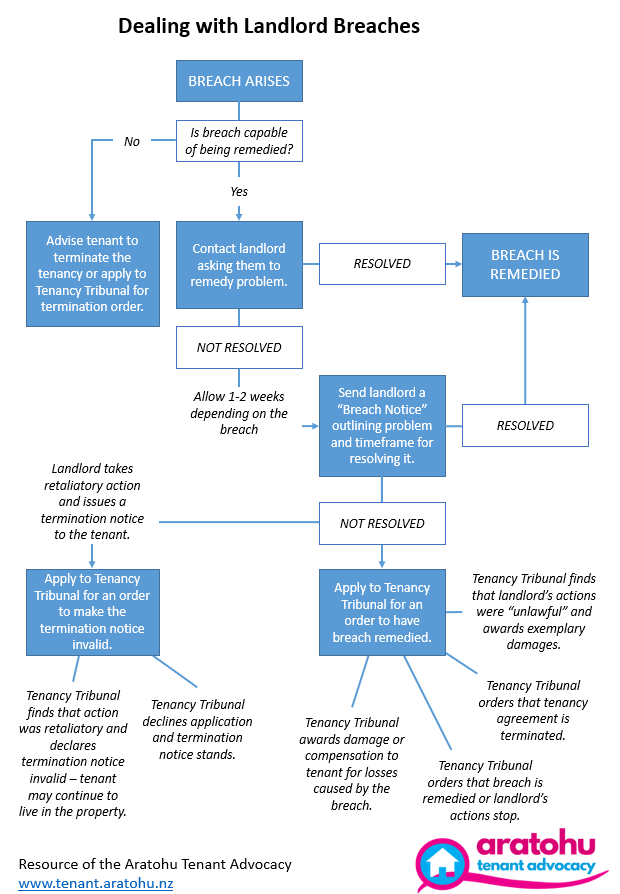When problems arise with a landlord, it’s generally best if the tenant is able to talk to them directly, or with the support of an advocate, to see if they can resolve things. This approach is sometimes referred to as ‘self-resolution’ and will generally be less stressful and time-consuming than using formal dispute resolution options.
However, if it’s clear that a landlord is breaching the tenancy agreement or failing to meet their legal obligations and the tenant has not had any success trying to sort things out, then going to mediation or using the Tenancy Tribunal can be a way of trying to resolve the dispute. The following flowchart shows strategies for dealing with landlord breaches.
Overview of mediation and the Tenancy Tribunal
The Tenancy Tribunal is an independent judicial body that provides a relatively quick and inexpensive way for tenants and landlords to resolve disputes. The Tribunal hears residential tenancy disputes involving claims up to $50,000.
The Tenancy Tribunal resolves disputes in two ways.
Mediation between the parties concerned
If mediation is unsuccessful or inappropriate, a hearing by a Tenancy Tribunal adjudicator, where a binding decision can be made.
Both mediation and the Tenancy Tribunal are intended to be forums where people are not intimidated by the legal process and where common sense solutions to disputes are worked out in a non-confrontational way. Where a matter cannot be resolved between a landlord and a tenant, either party (and not anyone else) can have that matter referred to the Tenancy Tribunal for an order or decision.
The mediation service encourages landlords and tenants to settle disputes in cooperative, non-confrontational ways and by mutual consent. Agreements reached in mediation are confidential and not available online.
If this doesn’t work the matter is referred to the Tenancy Tribunal for a decision. The Tenancy Tribunal can also formalise what has been agreed between the landlord and tenant during mediation.
Tenancy Tribunal hearings are conducted in a less formal way than Court hearings but follow the same overall procedure. In most cases, tenants and landlords must represent themselves at any hearing or meeting — they cannot typically use advocates or lawyers, but can bring a support person. For more information, including situations where representation may be possible, see Representation.
The Tenancy Tribunal does not deal with disputes between flatmates, or disputes in private boarding situations - these are generally dealt with in the Disputes Tribunal.
FastTrack Resolution
Tenancy Services also provides a FastTrack Resolution service which helps formalise agreements reached between tenants and landlords. This service is usually used in relation to sorting out an agreed way for the tenant to get on top of overdue payments, eg, for rent, bond or utilities.
If a landlord and a tenant want to formalise an agreed resolution to a dispute, the landlord can apply for FastTrack Resolution.
Once an application is made by the landlord, a mediator will call the tenant within two business days to check that they have understood and agreed to the application. If they agree this can result in the agreement being formalised as an enforceable mediated order.
If the tenant does not understand or agree with the application, the mediator will try and call the landlord immediately on a three-way call to resolve this.
If the mediator is unable to make contact with the tenant within two business days the application will be referred to the Tenancy Tribunal.

